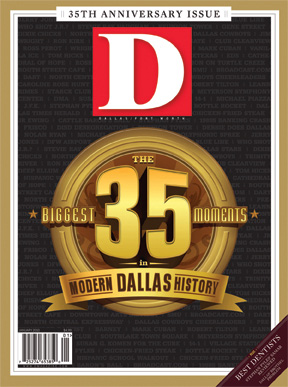For years, it appeared that Frisco was located on the wrong side of State Highway 121. While its neighbors to the south flourished, Frisco had stalled. Families new to the area—many of them priced out of Plano and elsewhere—were starting to move to the city in the 1990s, but commercial development was slow to follow. Not from lack of effort: there is a story, possibly apocryphal, about the mayor hiring someone to bulldoze a field to create the illusion that things were happening. (Depending on whom you believe, he was actually driving the bulldozer.) But such theatrics were no longer necessary by the time Stonebriar Centre opened in August 2000. The city was well on its way to becoming a dominant economic engine in the region.
When I started as Frisco’s first city manager on November 1, 1987, Frisco’s population was approximately 5,000, and the city had adopted its home rule charter in May of that year calling for a council-manager form of local government. I had just come from Columbus, Texas, a town of 4,000, which is located approximately 70 miles west of Houston.
Much like today’s economy, the stock market had just taken a huge tumble in October 1987, and the economy around Houston at that time was in a complete freefall. Within a few days of starting work in Frisco, a local real estate agent took me on a tour and pointed out two fairly large subdivisions being developed (Plantation Resort and Preston Vineyards), along with the Frisco Jetport. Compared to what had been happening in Columbus, Frisco looked like the promised land.
Within a year or so, Plantation Resort and the Frisco Jetport both ran into financial trouble. Though Plantation Resort would ultimately be developed out, the Frisco Jetport was never completed and eventually went away. So, though I was initially impressed that Frisco had the looks of immediately taking off, it became apparent that the impetus for development would go away as the Resolution Trust Corporation started taking over property after property.
In the early 1990s, the economy started coming back, and the biggest issue facing Frisco was to get major development to cross the State Highway 121 barrier. It seemed at the time that an invisible wall had gone up along the north right-of-way line of the roadway. The first crack in the wall occurred in 1995 when the Collin County Community College District Preston Ridge campus in Frisco opened.
The wall was completely torn down when Stonebriar Centre mall opened in August 2000. Though Frisco had been growing during the 1990s, the opening of Stonebriar Centre appeared to be the catalyst to confirm that Frisco had indeed arrived as a major player in the Dallas economy.
Though I have a difficult time identifying only one event that destined Frisco’s growth, there is no doubt that Frisco’s success has been built upon a combination of being in the right location and having elected leadership with the patience it took not to settle for anything that happened to come our way, but instead demanding quality growth.
The result has been that Frisco is today a city of more than 97,000 with the sixth-largest tax base in North Texas and is in the top 20 in sales tax receipts in the state.
George Purefoy has been the city manager of Frisco since 1987.







